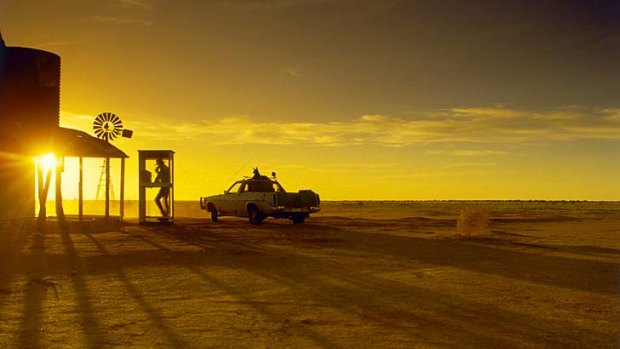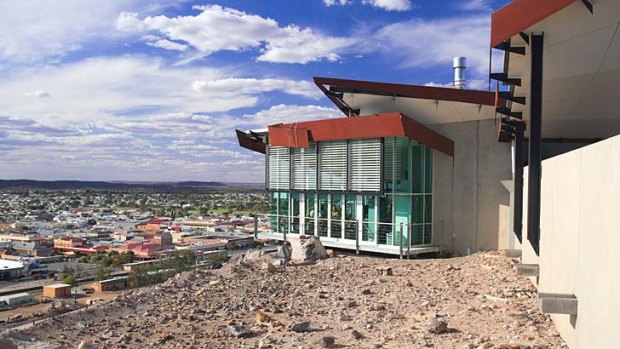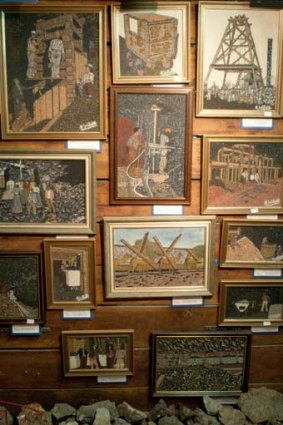
Western star ... the ubiquitous ute, favoured transport in Broken Hill.Credit: Getty Images
Elissa Blake takes an art-lover's tour of Broken Hill, with larger-than-life characters and even larger landscapes.
Rusted iron. Rich olive. Cappuccino. Dirty gold. An array of warm purples and greys. The colours emerging from the rocky outcrops just outside Broken Hill have been inspiring painters for decades. As the sky turns rosy pink in the Living Desert Reserve, over 12 massive sculptures carved from 52 tonnes of Wilcannia sandstone, I can see why this semi-arid city on the edge of the outback is a magnet for painters and art lovers.
Many of those artists, some of them former miners or their descendants, were inspired to pick up paintbrushes by the example of Pro Hart, the ebullient miner-turned-art celebrity whose irreverent images of gamblers, drunks and local characters are famous around the world. Like Hart, who died in 2006, most of these artists are self-taught and welcome visitors to their own galleries - often the front room of their homes.

The Broken Earth complex.Credit: Alamy
The locals say there is a sense of "spirit" in this country. In the silence, the vastness of the landscape and the sky certainly put you in your place. "I see the landscape as almost prehistoric," Ian Howarth says as he scans the 360-degree view of the scrubby plains bordered in the distance by the Barrier and Flinders ranges. "It's so weathered and worn. It carries the weight of aeons of time. It's almost the land that time forgot."
Howarth is the gallery assistant at the Regional Art Gallery, established in 1904. He is driving me about town in his ute. Every second car is a four-wheel-drive in Broken Hill, he says, laughing. "The rest are utes. No one walks anywhere. It's either too hot, too cold or too windy."
The main street is incredibly quiet and pedestrians are few - maybe everyone is in their car. But those residents I do meet are lively, generous with their time and quick to laugh. About 18,000 people live here, an ageing population with pockets of young families and transient workers. Everyone I meet feels a deep connection to the history of the city.

The Mineral Art and Mining Museum.Credit: Alamy
"It used to be a pretty rough town with boxing and wrestling every Saturday night," says artist Jack Absalom, 84, one of the grandfathers of the art scene. "All disputes were settled on a Sunday morning with fisticuffs. Now it's all calmed down." He remains as feisty as ever, telling me Sydney would be nothing but a fishing village without the wealth extracted from the mines in Broken Hill. "Sydney people are parasites on the community."
Absalom's gallery is a headline attraction on the Broken Hill art tourist trail. He is the only surviving member of the Brushmen of the Bush still resident in the town. The five Brushmen - Hart, Absalom, Hugh Schultz, Eric Minchin and John Pickup - painted landscapes in the Broken Hill area and gained fame in the art world in the 1970s, exhibiting across Australian and in London, Rome, New York and Los Angeles. The only other surviving member is Pickup, who now lives in Queensland. Absalom shows me an impressive range of minerals and opals in his gallery and tells me how he chose to paint on "huge canvases" to capture the isolation and the dry, brick-red beauty of the earth.
"Of course, now it's all bloody green," he says. "We've had the first big rains since 1973 and the whole place is green."
Green isn't the word I would have chosen to describe the vegetation masking the famous red dirt. But it's certainly on everyone's mind. In August last year, the city lost its chance to feature in George Miller's Mad Max: Fury Road, the fourth instalment in the Mad Max series. Despite years of preparation for the shoot, the landscape was deemed insufficiently post-apocalyptic after heavy rain resulted in wildflowers blooming in the desert. The Namibian desert was chosen for the shoot instead.
It was a heavy blow to an area whose film-production CV includes Mad Max 2, Wake in Fright, Razorback, A Town Like Alice, Dirty Deeds and Priscilla, Queen of the Desert. Broken Hill's cavernous central power station, built in 1931 and operated until 1986, has been converted into a film studio - the city is trying to attract more productions.
I head over to Pro Hart's gallery, the most popular art attraction in Broken Hill, to meet his widow, 73-year-old Raylee Hart, and his son, John, also a painter. She tells me Hart put Broken Hill on the map and opened visitor's eyes to the history of the mines, which dates to the discovery of silver ore in 1883.
"There is a lot of living history here," she says. "The mines are still here and the little miners' cottages made out of corrugated iron are all still here. Everyone is restoring their awnings and verandahs in heritage colours. It's not just an artist's paradise; there is so much history here that we're proud of."
Charles Sturt was the first European explorer to pass within sight of the "broken hill" in 1844, a rocky ridge jutting above the plains, an outcrop of what was then the richest deposit of lead, silver and zinc in the world. But it would be another 40 years before boundary rider Charles Rasp pegged the first mineral lease in the area, attracting thousands of miners from the declining copper towns in South Australia, as well as the Victorian goldfields.
Broken Hill, often called the Silver City, has enjoyed (and endured) 127 years of continuous mining activity. Its people have witnessed the birth of the trade union movement, several momentous strikes (one in 1919 lasted 18 months) and many booms and busts.
Rae Dellar tells me all about it. She is 66 and works at the Broken Hill Visitor Information Centre, and there isn't much she doesn't know about the town and its people. During a two-hour walking tour of the town with Dellar, I learn about the history of the mines and the railway line, the town's myriad architectural styles and its pride in the union movement. She points out the rambling Sturt's desert peas in bloom by the railway station and the crystals and minerals in the city's three mineral museums. Most of the streets in town are named after minerals or chemical compounds: Crystal, Mercury, Bromide, Sulphide, Oxide.
The most remarkable feature of town is the enormous Line of Lode (affectionately known as the slag heap), a mountain of residue from silver-ore smelting that divides the town through its centre. At its top sits a cafe-restaurant, the Broken Earth, with panoramic views. From here you can see that Broken Hill is an oasis, a thriving metropolis in the middle of seemingly endless flat terrain sprinkled with saltbushes and mulga trees.
Just outside is a stark memorial to the workers who died in the city's mines since the late 19th century - more than 700 people. Each miner is listed with his name, age and cause of death: asphyxiation from dynamite fumes, premature explosion, dust on the lungs, lead poisoning, rockfalls. Underground safety improved over time but deaths were not uncommon. One miner is listed as being crushed by an ore truck. Another died by being caught in belting. One man was killed in a remote-controlled loader accident. It is a stark reminder that mineral wealth does not come cheap. The youngest miner is listed as only 12 years old. "He might have been younger," Dellar says. "Boys often lied about their age."
She knows all the town's plaques and memorials. There's one to remember opera star June Bronhill, the local girl who changed her name from Gough to Bronhill (a contraction of Broken Hill) in gratitude to those who raised money to send her to London to train. Another pays respect to Vivian Bullwinkel, a sister at the Broken Hill hospital and the only survivor of the Banka Island massacre, in which 21 Australian nurses were shot by Japanese soldiers in 1942.
We finish our tour at the Palace Hotel, where scenes from Priscilla, Queen of the Desert were filmed. A family is on the verandah playing a board game. Inside, the bar is a mix of period furniture and low lights. More than a pub, the Palace is a living museum that pays tribute to Broken Hill's history, characters and the city's future as an oasis of artistic endeavour.
Opposite the hotel is Broken Hill's World War I memorial, where a statue of an Australian soldier in battle-worn uniform is about to hurl a Mills bomb. Dellar smiles. "There's a saying that in a mining town, never blow up a hotel."
Elissa Blake travelled courtesy of Destination NSW.
FAST FACTS
Getting there
Regional Express Airlines flies from Sydney (via Dubbo) and Melbourne (via Mildura) with fares ranging from about $520 to $900 return, about two hours. The distance from Sydney is 1165 kilometres and from Melbourne 849 kilometres. The Indian-Pacific (Sydney to Perth via Adelaide) stops at Broken Hill twice weekly. From Sydney, the CountryLink Outback Explorer operates weekly. V/Line trains from Melbourne connect via a coach service from Mildura (Buses R Us, from $84).
Staying there
Royal Exchange Hotel has art deco grandeur and fine dining in the main street with double rooms from $110. Phone (08) 80872308, see royalexchangehotel.com.
The Palace Hotel has comfortable, if basic, retro-style accommodation from $80. Phone (08) 80881699, see .
The 4½-star, immaculately restored Astra Boutique Hotel is an imposing heritage building in the main street dating to the 1890s. It offers luxury accommodation, a cocktail bar and fine dining in Trinders Restaurant downstairs. Double rooms from $175. Phone (08)80875428, see theastra.com.au.
The city has more than 60 self-contained cottages (some of them miners' cottages), cabins, apartments, from $125 a night, and two caravan parks with cabins and sites, from $25. See .
Eating there
Royal Exchange Hotel, the Palace Hotel and the Astra all have excellent lunches and dinners. Try the Broken Earth cafe-restaurant atop of the Line of Lode for sunset views; phone (08) 8087 1318.
Bells Milk Bar is a quirky, intact 1950s milk bar in South Broken Hill serving original-recipe syrups in milkshakes and soda spiders. Phone (08) 8087 5380, see bellsmilkbar.com.au.
Touring there
The Broken Hill Visitor Information Centre is the hub for all walking tours and coach tours, and the source of maps and artist trails. Phone (08) 8080 3560.
You'll need a car to get around. Avis, Thrifty and Hertz are available. A four-wheel-drive is recommended for remote areas.
While there
The Broken Hill Regional Art Gallery has about 1700 paintings and works on paper by artists including John Olsen, Arthur Streeton, Rupert Bunny and local indigenous artists. Pick up maps to all the other local galleries here. Phone (08)80803440.
There are three mineral museums: Albert Kersten Mining & Minerals Museum, home to the famous Silver Tree sculpture, (08)80803500; White's Mineral Art Gallery and Living Mining Museum, home to former miner and now artist Kevin "Bushy" White, (08)80872878; and Silver City Art Centre and Mint, with a large array of minerals, an extensive range of jewellery, ceramics and glass, and the world's largest acrylic painting.
The historic ghost town of Silverton is 25kilometres north-west of Broken Hill. Have a drink in the Silverton Hotel, one of the most filmed and photographed pubs in Australia. Visit the Mad Max Museum, the Silverton Gaol Museum, the Horizon Gallery and the Silverton Outback Gallery. Don't miss the Mundi Mundi Lookout for stunning scenery. See .
The Living Desert Reserve is nine kilometres from Broken Hill; the sculpture site is open daily until dusk. Entry $10.
More information
Sign up for the Traveller Deals newsletter
Get exclusive travel deals delivered straight to your inbox. Sign up now.